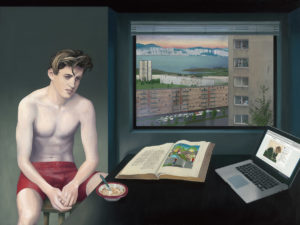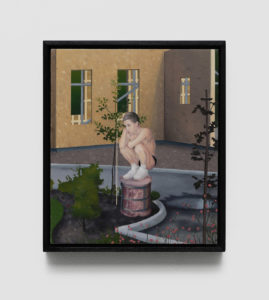Photographing the social condition of individuals in the era of social media, using a technique with which manuscripts and miniatures were adorned in the Middle Ages. A leap between two so distant time spaces, accentuated by the coexistence of chronologically distant elements, thanks to which Jean Claracq outlines the iconography of contemporary melancholy. Almost thirty years old, graduated from the Ecole des Beaux Arts in Paris and now courted by institutions such as the Vuitton Foundation for contemporary art which gave him carte blanche in his Open Space # 7 dedicated to emerging artists; this singular artist creates masterpieces on a few centimeters of canvas which, as he himself says, after a few hours of work “become immense”.
If the A View from an Apartment picture has the “reasonable” size of 120×90 cm, the measures of the artist’s creations are usually in the order of 10x15cm and even 4×6 cm, that is, slightly larger than a stamp. Despite the narrowness of the format, the universe in which Jean Claracq’s stories evolve is vast and extremely articulated. Looking out onto his paintings like a window, one realizes that they open towards other windows in a duplication of images whose details are so rich as to divert the viewer’s attention from the main subject for a moment. However, we end up going back to the protagonist, a boy often in underwear or in a bathing suit, as guided by an inexplicable impulse.
Wandering through the maze of vast infrastructures built with mathematical minutia, almost too realistic to seem improbable, one realizes the loneliness and alienation of that boy halfway between adolescence and adulthood. Sitting in front of a cup of cornflakes in the aforementioned A View from an Apartment, the young man appears, perhaps due to the effect of the quarantine experience we have lived, sad and lonely, as are his neighbors. So perhaps, the view of which the title speaks, is not that which can be admired from the window of the protagonist’s apartment, but that of the open book or computer screen where you can see a man locked up in himself.
We are close but even further away, technology has led to this, the characters of Jean Claracq seem to mean. In Landscape with the Temptation, one of them sits in a bathing suit on the edge of a precipice admiring an administrative building at a distance that is devastated by flames. How to interpret the title this time? Is the temptation to throw himself into the void? Or is it the desire to set fire to a property, evidently already satisfied? The number of hypotheses seems to be lost in the tunnel to which the long double bass road leads.
The same feeling is perceived in Monument to the Vanquished, whose title and position of the subject depicted, clearly refer to a sculpture project imagined by the Nordic Renaissance painter, Albrecht Dürer, in relation to the War of the Peasants (1524). As much as that of his illustrious predecessor, the work of Jean Claracq, is rich in mystery and lends itself well to an ambiguity in interpretation. This time the boy in a bathing suit is perched on a column, his head resting on his closed hand and the usual melancholic air. On his chest, the dagger that Dürer had stuck in the farmer’s back turned into a tattoo. And here comes the idea that that boy is the modern peasant and that he embodies, like the latter, the symbol of social discontent of which young people are often the spokespersons.
If this is perhaps the underlying message, the ideas offered by Jean Claracq’s paintings seem to be infinite, and are transmitted to us by the artist with all possible means, from the Flemish Renaissance to Instagram, from medieval works to video games. Each piece of this studied puzzle fits past and present to encourage us to reflect on the future. What will happen to us if we continue to avoid looking around and turn our eyes only to screens smaller than Jean Claracq’s paintings? Of course, given the period we are living in, technology reveals itself as a virtual bridge that makes us feel closer. However, if we adopt the creative process of this artist, who prefers to work in the light of day, and we also abandon the virtual light of our screens for a moment, we will realize that if we take care of and preserve what surrounds us, we can actually find each other and we will never be alone.
Ilaria Greta De Santis
Info:
 Jean Claracq, A view from an appartement, 120 x 90 cm, Oil on wood, 2017. Courtesy Galerie Sultana
Jean Claracq, A view from an appartement, 120 x 90 cm, Oil on wood, 2017. Courtesy Galerie Sultana
 Jean Claracq, Monument to the Vanquished, 21×18 cm oil on wood, 2019. Courtesy Galerie Sultana
Jean Claracq, Monument to the Vanquished, 21×18 cm oil on wood, 2019. Courtesy Galerie Sultana
 Jean Claracq, Landscape with the temptation 25 cm. Oil on wood, 2019. Courtesy Galerie Sultana
Jean Claracq, Landscape with the temptation 25 cm. Oil on wood, 2019. Courtesy Galerie Sultana

Paraphrasing Fellini, I will tell you that I am an oyster and my path is a grain of sand that is turning into a pearl. From law degree to art history degree at the Sorbonne in Paris. From the French capital I tell you about art.






NO COMMENT